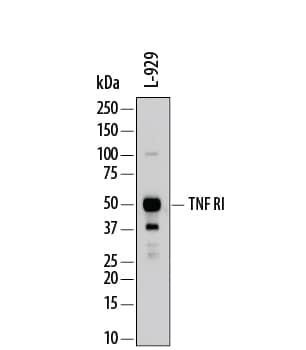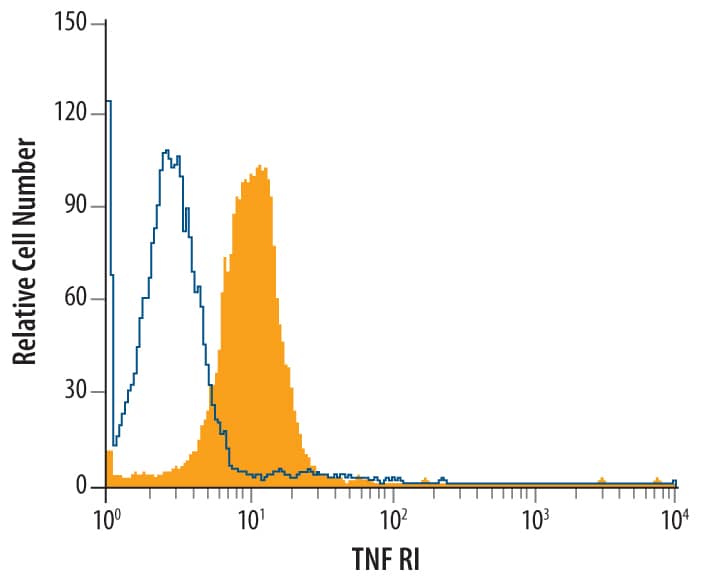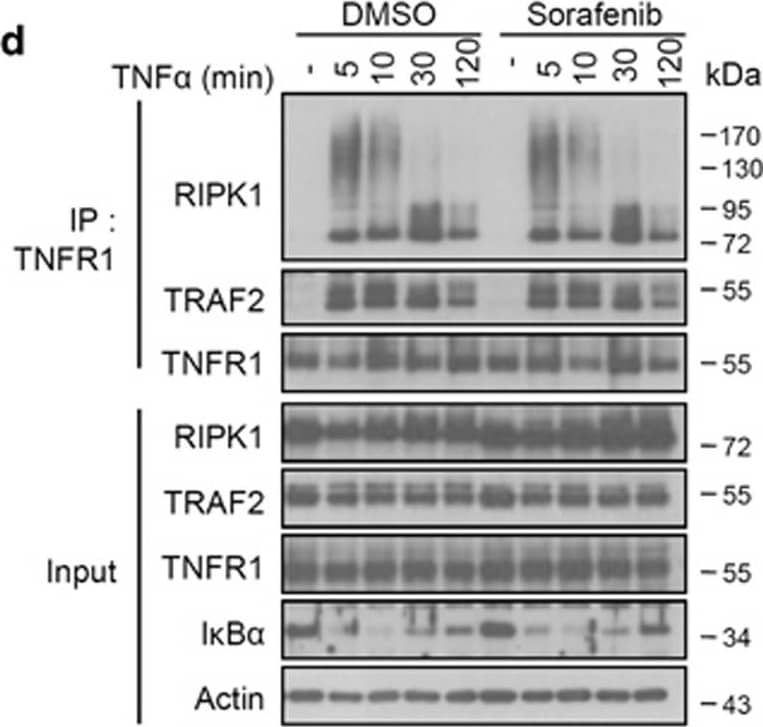Mouse TNF RI/TNFRSF1A Antibody
R&D Systems, part of Bio-Techne | Catalog # AF-425-PB


Key Product Details
Species Reactivity
Validated:
Cited:
Applications
Validated:
Cited:
Label
Antibody Source
Product Specifications
Immunogen
Ile22-Ala212
Accession # P25118
Specificity
Clonality
Host
Isotype
Endotoxin Level
Scientific Data Images for Mouse TNF RI/TNFRSF1A Antibody
Detection of Mouse TNF RI/TNFRSF1A by Western Blot.
Western blot shows lysates of L-929 mouse fibroblast cell line. PVDF membrane was probed with 0.2 µg/mL of Goat Anti-Mouse TNF RI/TNFRSF1A Antigen Affinity-purified Polyclonal Antibody (Catalog # AF-425-PB) followed by HRP-conjugated Anti-Goat IgG Secondary Antibody (Catalog # HAF109). A specific band was detected for TNF RI/TNFRSF1A at approximately 50-55 kDa (as indicated). This experiment was conducted under reducing conditions and using Immunoblot Buffer Group 1.Detection of TNF RI/TNFRSF1A in L‑929 Mouse Cell Line by Flow Cytometry.
L-929 mouse fibroblast cell line was stained with Goat Anti-Mouse TNF RI/TNFRSF1A Antigen Affinity-purified Polyclonal Antibody (Catalog # AF-425-PB, filled histo-gram) or control antibody (Catalog # AB-108-C, open histo-gram), followed by Phycoerythrin-conjugated Anti-Goat IgG Secondary Antibody (Catalog # F0107).Detection of Mouse TNF RI/TNFRSF1A by Western Blot
Sorafenib does not influence complex I formation, but protects against necroptosis by targeting the necrosome complex. (a) L929 cells were pretreated with 10 μM Nec-1s, Sorafenib or DMSO for 1 h and stimulated with mTNF (10 ng/ml) for the indicated time. Cells were lysed and immunoblotted with the indicated antibodies. *Phosphorylated RIPK1. (b,c) L929 cells were pretreated with 10 μM DMSO, Nec-1 or Sorafenib for 1 h and stimulated with mTNF (10 ng/ml) for 2 h. The relative mRNA levels of mA20 and mI kappaB-alpha were analyzed by qRT-PCR. All bars represent mean±S.D.; n=3, ns=non-significant. (d) L929 cells were pretreated with 10 μM Sorafenib or DMSO and stimulated with mTNF (10 ng/ml) for the indicated time. Cell lysates were immunoprecipitated with anti-mTNFR1 antibody. (e,f) L929 (e) and HT-29 (f) cells were pretreated with 10 μM Nec-1, Sorafenib (Sora) or DMSO and stimulated with zVAD (10 μM)+mTNF (5 ng/ml) (L929) or zVAD (30 μM)+BV6 (1 μM)+hTNF (30 ng/ml) (HT-29) for the time indicated. Cell lysates were immunoprecipitated with the indicated antibodies and both immunoprecipitates (IP) and total lysates (input) were immunoblotted with the indicated antibodies (WB) Image collected and cropped by CiteAb from the following open publication (https://pubmed.ncbi.nlm.nih.gov/28661484), licensed under a CC-BY license. Not internally tested by R&D Systems.Applications for Mouse TNF RI/TNFRSF1A Antibody
Agonist Activity
The ED50 for this effect is typically 0.05-0.15 μg/mL.
CyTOF-ready
Flow Cytometry
Sample: L-929 mouse fibroblast cell line
Immunohistochemistry
Sample: Perfusion fixed frozen sections of mouse intestine
Western Blot
Sample: L‑929 mouse fibroblast cell line
Formulation, Preparation, and Storage
Purification
Reconstitution
Formulation
Shipping
Stability & Storage
- 12 months from date of receipt, -20 to -70 °C as supplied.
- 1 month, 2 to 8 °C under sterile conditions after reconstitution.
- 6 months, -20 to -70 °C under sterile conditions after reconstitution.
Background: TNF RI/TNFRSF1A
TNF receptor 1 (TNF RI; also called TNF R‑p55/p60, TNFRSF1A and CD120a) is a type I transmembrane protein that belongs to the TNF receptor superfamily (1, 2). TNF RI is widely expressed and is present on the cell surface as a trimer of 55 kDa subunits. It serves as a receptor for both TNF‑ alpha and TNF‑ beta/lymphotoxin. Each subunit contains four TNF‑ alpha trimer‑binding cysteine‑rich domains (CRD) in its extracellular domain (ECD) (1‑6). TNF‑ alpha binding to TNF R1 induces the sequestration of TNFRI in lipid rafts, where it activates NF kappaB and is cleaved by ADAM‑17/TACE (7, 8). Release of the 28‑34 kDa TNF RI ECD occurs constitutively, and in response to products of pathogens such as LPS, CpG DNA or S. aureus protein A (1, 7‑12). Full‑length TNF RI may also be released in exosome‑like vesicles (12). Such release helps to resolve inflammatory reactions as it down‑regulates cell surface TNF RI and provides soluble TNF RI to bind TNF‑ alpha (6, 13, 14). Exclusion from lipid rafts causes endocytosis of TNF RI complexes and induces apoptosis (7, 15). Although there is a second receptor for TNF‑ alpha (TNF R2), TNF RI is thought to mediate most of the cellular effects of TNF‑ alpha (3). TNF R1 is essential for proper development of lymph node germinal centers and Peyer’s patches, and for combating intracellular pathogens such as Listeria monocytogenes (1‑3). Mouse TNF RI is a 454 amino acid (aa) protein that contains a 21 aa signal sequence and a 191 aa ECD with a PLAD domain (6). This mediates constitutive trimer formation. The PLAD domain is followed by four CRDs, a 23 aa transmembrane domain, and a 219 aa cytoplasmic sequence that contains a neutral sphingomyelinase activation domain and a death domain (16). The ECD of mouse TNF RI shows 67%, 70%, 64%, 70% and 88% aa identity with canine, feline, procine, human and rat TNF RI, respectively; and it shows 23% aa identity with the ECD of TNF RII.
References
- Pfeffer, K. (2003) Cytokine Growth Factor Rev. 14:185.
- Hehlgans, T. and K. Pfeffer (2005) Immunology 115:1.
- Peschon, J.J. et al. (1998) J. Immunol. 160:943.
- Banner, D.W et al. (1993) Cell 73:431.
- Medvedev, A.E. et al. (1996) J. Biol. Chem. 271:9778.
- Chan, F.K. et al. (2000) Science 288:2351.
- Legler, D.F. et al. (2003) Immunity 18:655.
- Tellier, E. et al. (2006) Exp. Cell Res. 312:3969.
- Xanthoulea, S. et al. (2004) J. Exp. Med. 200:367.
- Jin, L. et al. (2000) J. Immunol. 165:5153.
- Gomez, M.I. et al. (2006) J. Biol. Chem. 281:20190.
- Islam, A. et al. (2006) J. Biol. Chem. 281:6860.
- Garton, K.J. et al. (2006) J. Leukoc. Biol. 79:1105.
- McDermott, M.F. et al. (1999) Cell 97:133.
- Schneider-Brachert, W. et al. (2004) Immunity 21:415.
- Lewis, M. et al. (1991) Proc. Natl. Acad. Sci. USA 88:2830.
Long Name
Alternate Names
Gene Symbol
UniProt
Additional TNF RI/TNFRSF1A Products
Product Documents for Mouse TNF RI/TNFRSF1A Antibody
Product Specific Notices for Mouse TNF RI/TNFRSF1A Antibody
For research use only

